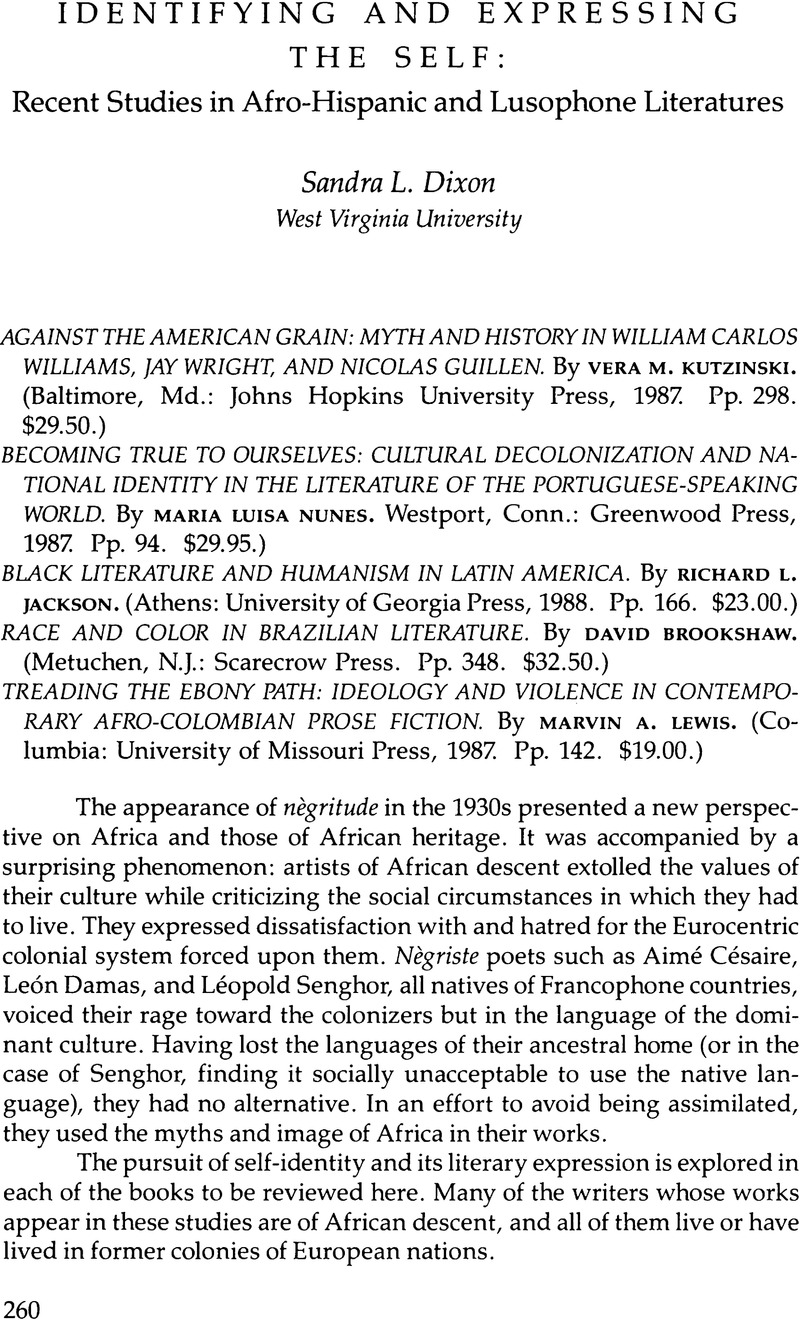No CrossRef data available.
Article contents
Identifying and Expressing the Self: Recent Studies in Afro-Hispanic and Lusophone Literatures
Review products
Published online by Cambridge University Press: 12 October 2022
Abstract

- Type
- Review Essays
- Information
- Copyright
- Copyright © 1990 by the University of Texas Press
References
Notes
1. This collaborative effort by Maria Isabel Barreno, Maria Teresa Horta, and Maria Velho da Costa contains letters, poetry, and prose. Nunes considers it to be “the most important piece of writing within the context of feminism to have appeared” in Portuguese literature (p. 27).
2. See Mikhail Bakhtin, Problems of Dostoevsky's Poetics, translated by R. W. Rotsel (Ann Arbor: Ardis, 1973).
3. Generally speaking, negrista poetry depicts Afro-Hispanic life. A detailed discussion of alternative descriptive terms for this type of poetry is found in Marvin Lewis's Afro-Hispanic Poetry, 1940–1980: From Slavery to “Negritud” in South American Verse (Columbia: University of Missouri Press, 1983).
4. Vera Kutzinski discussed the origin of the word algarabía: “it is likely that algarabía was associated with the oriental bazaars that came to be a familiar institution in the large, commercial centers of medieval Spain. Algarabía probably referred to the tumultuous chaos of those bazaars… [and thus] signifies the intense disorder of these markets represented by the confusing simultaneity of voices filling the air” (p. 181).
5. See José Donoso, The Boom in Spanish American Literature: A Personal History, translated by Gregory Kolovakos (New York: Columbia University Press and the Center for Inter-American Relations, 1977); and Luis Harss and Barbara Dohmann, Into the Mainstream: Conversations with Latin American Writers (New York: Harper and Row, 1969).
6. Distinctive features of negrista poetry are the use of rhythms reminiscent of African drumbeats, onomatopoeia, neologisms, and Afro-Latino dialect, as evidenced in the final stanza of Luis Palés Matos's “Danza negra”: “Calabó y bambú. / Bambú and calabó. / El Gran Cocoroco dice: tu-cu-tú. / La Gran Cocoroca dice: to-co-tó.”
7. See Alejo Carpentier, Ecué-Yamba-0 (Buenos Aires: Octavio Sello, 1977); and Rómulo Gallegos, Pobre negro (Madrid: Aguilar, 1971, 4th edition).
8. Marvin Lewis takes these categories of violence from Ariel Dorfman's Imaginación y violencia en América (Santiago: Editorial Universitaria, 1970).
9. Richard Jackson identifies “Latin American specificity” with African and indigenous cultures.
10. In Yoruba mythology, Changó (also Sangó or Xangó) is the son of Yemayá and Orungán. In the syncretic religions of Brazil and parts of Spanish America, he is identified with Saint Barbara and is venerated mainly as a god of war.




